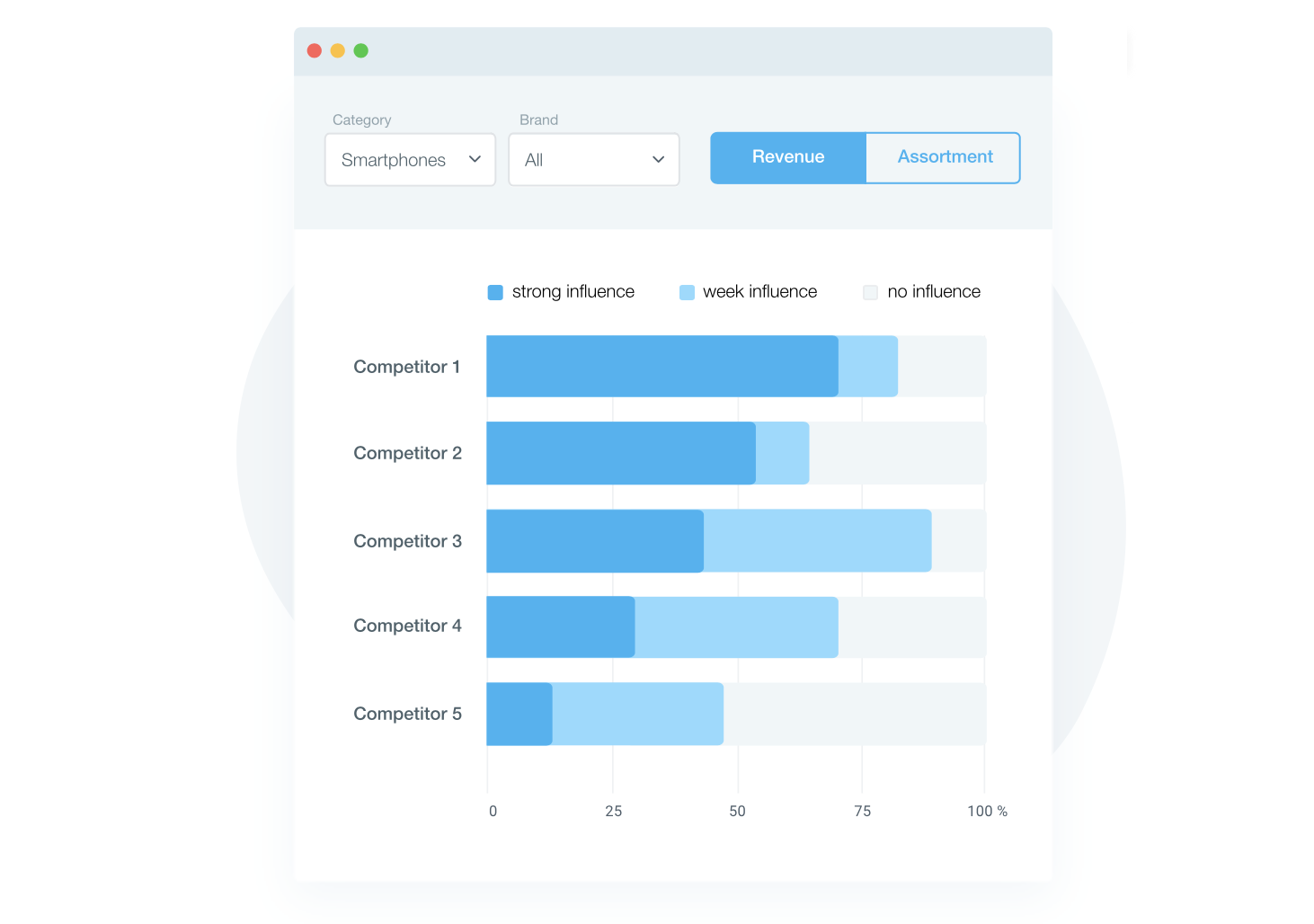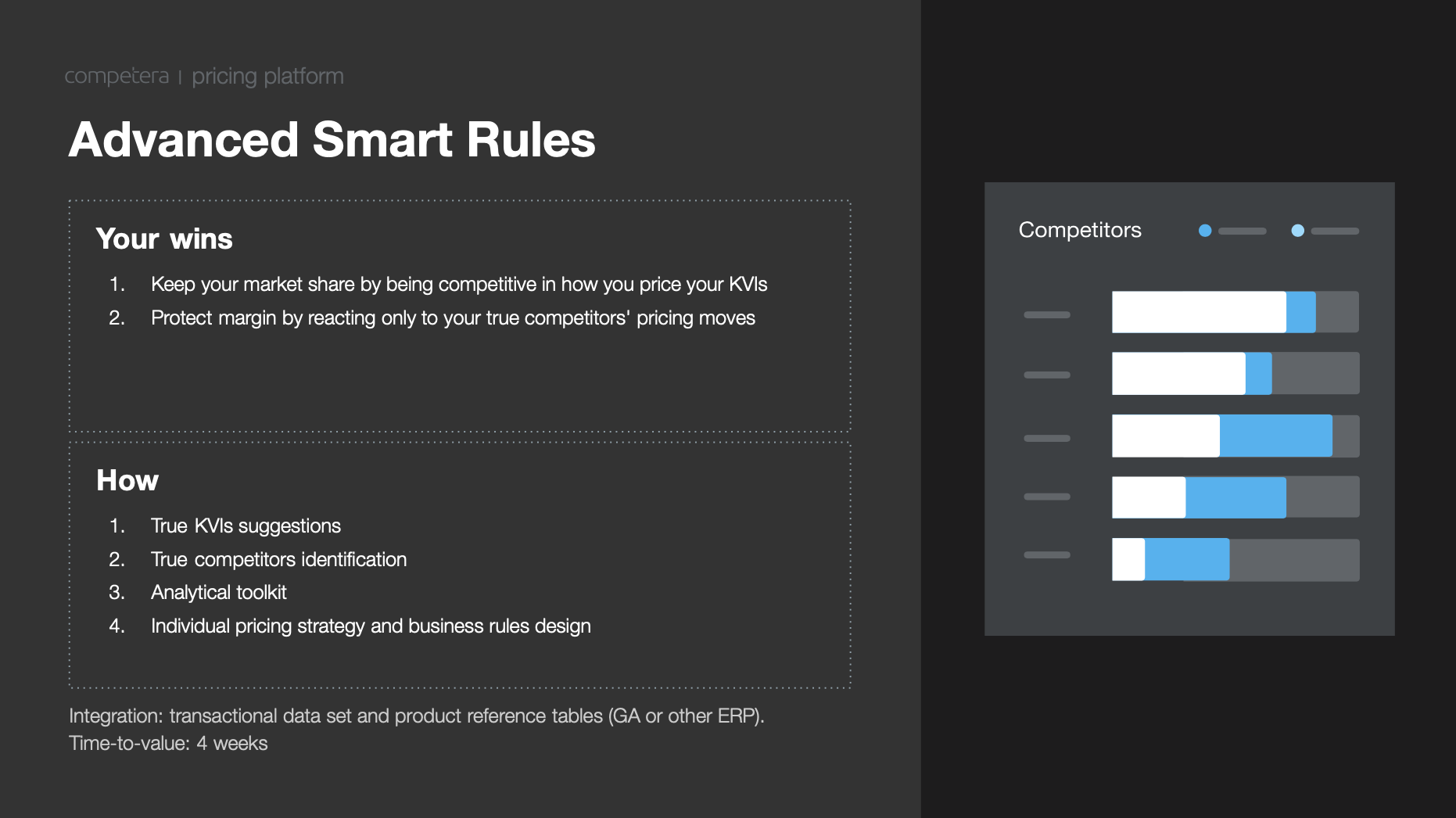Content navigation:
- What is competition-based pricing strategy?
- Why your business needs it?
- Ways to benefit from competitive pricing strategy
- How to implement it in your business
- Applicability and results of competitive pricing strategy
- Why does it matter?
- Recommendations
What is competitive pricing strategy?
The core principle of the competition-driven pricing is to determine the appropriate prices for the products considering the situation in the market. In particular, this strategy requires taking into account the prices from the rivalry companies rather than rely on the production costs solely. Also, competitive pricing involves the collection of the data and analysis of the profit margin under different circumstances.
The common competitive pricing definition implies the strategy of an enterprise to boost sales and gain a competitive advantage through the smart pricing which differentiates it from the rivals. Especially considering the economic situation in the world, the market-based pricing is now relevant in the industry due to the shift to the online retail business. This article aims to explain the basics of this pricing strategy, its significance to the retailers, provide successful examples of its implementation, and describe how it can boost your company.
Why your business needs it?
Market-based pricing is the most common practice for retail companies. Considering the high level of competition from a similar business, a retailer has to maintain a relevant position in the market and sustain profits. In this regard, the analysis of competitors' prices is the most effective method to preserve the flow of the customers. Without knowing the pricing of the rivals, a retailer might set the price, which would be much higher. However, the value of the products would be the same for the consumer.
To avoid the scenario when your business offers the product or services for the higher prices than the competitors, it would be wise to utilize the AI-driven pricing solutions. The advanced software considers the data from the industry competitors. The software utilizes the market-driven pricing helps to boost the revenues, liquidate the excess inventory, and optimize the prices for the luxury products. Moreover, this solution is much more effective and convenient than the manual analysis of the market and data synthesis.
Competition-based pricing is not as simple as it might appear at first sight. The general idea of collecting competitive data and adjusting prices based on is not easy when it comes to real life. Dozens of challenges arise right when a retailer decides to price SKUs in regard to the competition. The risk of following false or unnecessary competitors is probably one of the most common challenges. In addition, the role each SKU plays in the portfolio is also changing: the product which used to a 'best price guarantee' months ago might, eventually, turn into a long tail item waiting for markdown tomorrow.
To tackle these challenges, retailers have no other choice than using ML-driven pricing solutions. Why? As practice shows, only 3 out of 10 competitors selling the same product might have a real impact on you. Moreover, they might be different in every category or segment.

Using Competera pricing platform, retailers can identify the strength of each competitor’s negative impact on business sales. To do this, we use an algorithm called “True competitors.” Based on three main factors (competitors’ prices, your price, and sales), it compares every product in your portfolio against competitors who put pressure on your sales and identifies the root causes of the present situation. What’s most importantly, thanks to ML technologies, the algorithm can match prices even where they are difficult to identify, e.g., marketplaces.
As a result, you can save your money, avoid the need to mimic the cheapest market players, and offer your customers a fair price.
Ways to benefit from competitive pricing strategy
Discussing the most evident opportunities of the market-driving pricing, one may mention the following:
- The advantage over the rivals due to the lower price
- Flexible price point considering the shifts in the market
- Relevant rates which meet the demand of the consumers
- Revenue growth through the prices on the unique products
However, despite the advantages of a competitive pricing strategy, there are also drawbacks and complications. For instance, there might be the following disadvantages associated with this approach:
- The decision to rely only on the competitor pricing might lead to loses from the production and margin costs
- Miscalculations in the pricing strategies and categorization of the competitors
- Lack of data regarding the prices and activities of the rivals
Considering that most of the cons of market-driven pricing are related to the human factors and ineffective business decisions, the most appropriate tool for this approach is the AI-based solution. Therefore, with the advanced software which provides precise pricing decisions and determines the quality and parameters of the data, any retail business can boost the revenues and maintain a solid position on the market.
How to implement it in your business
Before utilizing the competition pricing strategy, it is crucial to be aware of how it can benefit your enterprise. Namely, a retailer has to recognize how it works, for what purposes it is suitable, and why it is important. Therefore, let's try to answer the most frequently asked question regarding this pricing strategy.
- How to use it?
Market-driven pricing strategy considers the prices, deals, and other activities of the competitors as the benchmark to establish the effective rates on the products.
- Why my business needs it?
This strategy allows maintaining the relevant position in the market with appropriate competitive prices.
- What type of data is needed?
The retailer has to analyze the competitors' quality of products, price index, discounts, availability of the goods. In addition, the most precise results require the data from previous years.
- How this strategy provides pricing suggestions?
It is important to ensure that every pricing decision is coherent with an overall business strategy, so goals at different levels and channels are aligned. Every solution provider has its own approach to help retailers align pricing. At Competera, we provide users with a single self-service platform so all the stakeholders can access a single dashboard, understand how a particular recommendation was made, and gain full control over pricing.
The most effective method to calculate the market-driving pricing is to use the software. It can analyze the data within a short period of time. All you need is to fill in the required data, set goals, and select the desired searching tools.
Applicability and results of competitive pricing strategy
The market-driven pricing is peculiar not only to the online business but also to the apparel industry and famous brands. Frequently, this pricing approach is the most effective for the companies which have the number of direct rivals that sells similar products and provide the same services and value to the customers. In this regard, it is also vital to offer higher value than rivals. Although the customers are more likely to respond to the lower price, they also might be willing to spend more if a product has unique value or additional offer attached.
Nevertheless, the competition between Coca-Cola and Pepsi is the case when the sales depend on the prices. Since the products of these two companies are relatively similar, Coca-Cola employed the pricing strategy which set lower prices than the competitor Pepsi. As a result, Coca-Cola managed to increase the revenue through the high volumes of production and yet with the lower price.
Why does it matter?
The primary reason why this strategy is relevant for the retail business is the notion that every company in the business has its own advantages and can provide unique value for the consumers. To maintain the high position and revenues in the market, a retailer has to assure that its prices match the competitors. Considering that 80% of consumers compare the prices online before making any purchase, it is vital that the rates of your company would not scare away the customer when they do the research.
Another factor in favor of a market-driven pricing strategy is the attraction of loyal customers. Through effective pricing, a retailer can convey the value, uniqueness, and quality of products that the company offers. The lower prices might serve as part of the marketing strategy to appeal to initial consumers. Subsequently, a retailer can adjust the pricing in both ways according to the position in the market and demand.
Finally, this strategy is the possibility of switching to advanced market-driven pricing empowered with customisable pricing rules for any SKU in retailer's portfolio. Thanks to technologies, the rules logic can be based on any data and variables with advanced product bucketing (KVIs, Long tail, Cash generators, etc).

Final recommendations
All in all, the competitive pricing strategy is the most suitable solution for retailers and businesses which have a significant number of rivals. With this approach, a company has the opportunity to gain advantage over the competitors using effective pricing.
However, this method requires the consideration of multiple factors and thorough data analysis. Since manual calculations could be extremely time-consuming, the AI-driven pricing software could suggest the most suitable strategy for any business. Moreover, with the software-based solutions, there is always the possibility to adjust to the conditions on the market to reach the desired goals.
FAQ
In case a competitive pricing strategy is used ineffectively, it can lead to margin dilution and lost profit. In addition, it might also negatively impact customer loyalty.
Lasting low pricing policy can reaffirm the customers' loyalty by contributing to the shop's market perception as a low-cost seller.






